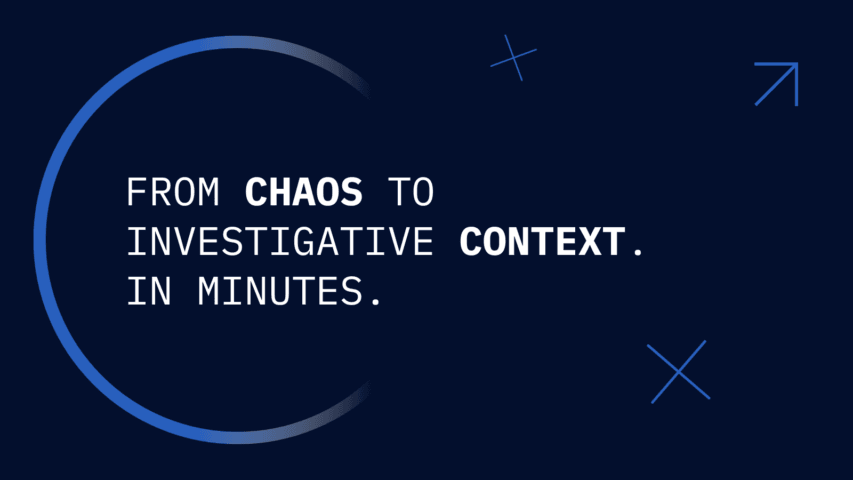
From Chaos to Investigative Context.
In Minutes.
A Mission to Uncover the Unknown
During a meeting with one of our customers, someone said a sentence that perfectly captures the mission shared by all analysts and investigators:
“Our goal is to detect the undetected.”
Whether you work in banking, insurance, law enforcement or defense, every day you face the unknown. You don’t always know which questions to ask at the start, what data you will need tomorrow, or which patterns will turn out to be critical.
ACCELERATE YOUR INVESTIGATIONS WITH PROVEN STRATEGIES AND LESSONS FROM REAL-WORLD SUCCESS STORIES.
Gain access to the DataWalk articles and case studies
For FinCrime Investigators
Gain access to the DataWalk articles and case studies for FinCrime Investigators
Gain access to the DataWalk articles and case studies for FinCrime Tech Professionals
At the same time, the environment you operate in is becoming increasingly complex. The amount and diversity of available data is growing exponentially — from transactional, behavioral, and communication data to sensor feeds, OSINT streams, and unstructured documents. There’s a constant stream of new systems, formats, and datasets that must be connected to understand the full context.
The ability to uncover hidden relationships in this ocean of data often determines whether an organization can dismantle a criminal network, prevent an attack, or stop a major financial loss.
Despite enormous technological progress, most institutions still operate reactively — analyzing cases only after they occur. More and more organizations, however, realize that this model is not enough and are moving toward a proactive approach: early detection and prevention of risks before they become problems.
At the same time, regulatory pressure, reputational risk, and financial consequences are forcing organizations to act. Regulatory fines now reach billions of dollars, while losses due to fraud and abuse are estimated at over $5 trillion globally each year, and cyber-enabled fraud alone caused $16.6 billion in reported losses. This scale of damage, combined with growing scrutiny, drives organizations to adopt proactive, intelligence-driven operating models.
In this article, we will review why traditional solutions struggle to detect the undetected and how DataWalk empowers analysts with this breakthrough capability.
ROI in Weeks: How a Leading U.S. Bank Saved Over $40M Annually with DataWalk
Learn More >>>
ROI in Weeks: How a Leading U.S. Bank Saved Over $40M Annually with DataWalk
Data Foundation: From Chaos to Context
The biggest obstacle to uncovering complex criminal networks and activities is a lack of coherent context. In most institutions, data is fragmented across dozens of systems, stored in different formats, and lacks logical connections. Some examples:
- One of the world’s largest banks handles AML alerts using six different systems, and analysts still copy data into Excel to manually correlate facts.
- Another global bank, in its first line of defense, relies on six to nine separate data sources before an analyst can even begin case review — turning a task that should take three minutes into twenty-three.
- An intelligence agency receives up to 100 new unstructured data sources every week, but cannot efficiently combine them into a single operational picture.
AI tools should be able to help, but without an ontology and knowledge graph even the most advanced AI models cannot deliver trustworthy results.
DataWalk was created to solve these challenges. Our platform is built on a hybrid graph-relational architecture that unifies structured and unstructured data into a single, coherent contextual model structured however you desire. Data from multiple sources is automatically matched, and the relationships between them form a knowledge graph with an ontology that acts as a shared language for the entire organization.
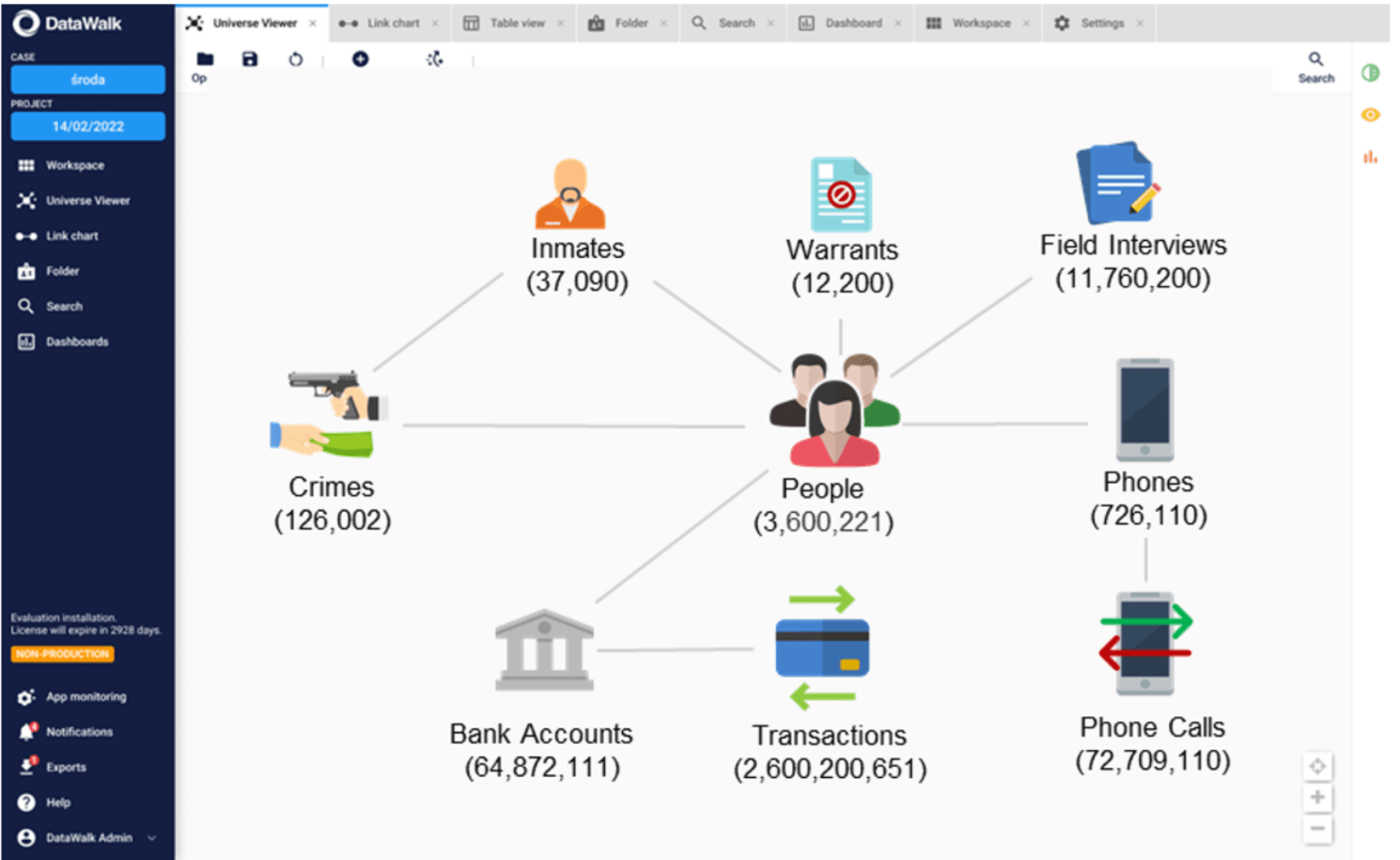
Figure 1: A DataWalk Knowledge Graph. Data is organized around understandable sets of objects and the relationships between them.
As a result, analysts see the full picture — not disconnected fragments — and can instantly discover connections between people, accounts, companies, events, and anything else that would otherwise remain hidden.
DataWalk extends this foundation further by combining two complementary worlds:
- Semantic networks (known from RDF and OWL) act as a language for representing knowledge — ideal for feeding LLMs or discovering new relationships through inferencing.
- Property graphs, in turn, are built for advanced analytics — quickly uncovering criminal networks, hidden intermediaries, or criminal associations across massive data volumes.
DataWalk seamlessly unites both. Analysts no longer need to choose between semantic richness and analytical speed — they get both in one environment.
Cracking a $5.7M Fraud in 120 Minutes
The Power of Agile Investigation With DataWalkLearn More >>>
Cracking a $5.7M Fraud in 120 Minutes
The Right Tools: Fusing Techniques in One Unified Environment
Combining data is just the beginning. True value emerges when analysts can explore it from multiple perspectives and combine diverse techniques in one place to solve the most complex cases and answer the most difficult questions.
In most organizations, these techniques — full-text search, graph analysis, OLAP, rule engines, and machine learning — exist in isolation across different systems. Adding a new data source or testing a new hypothesis can require weeks of coordination.
DataWalk Composite AI Core removes these barriers. It integrates an array of analytical techniques with the knowledge graph and reasoning engine.
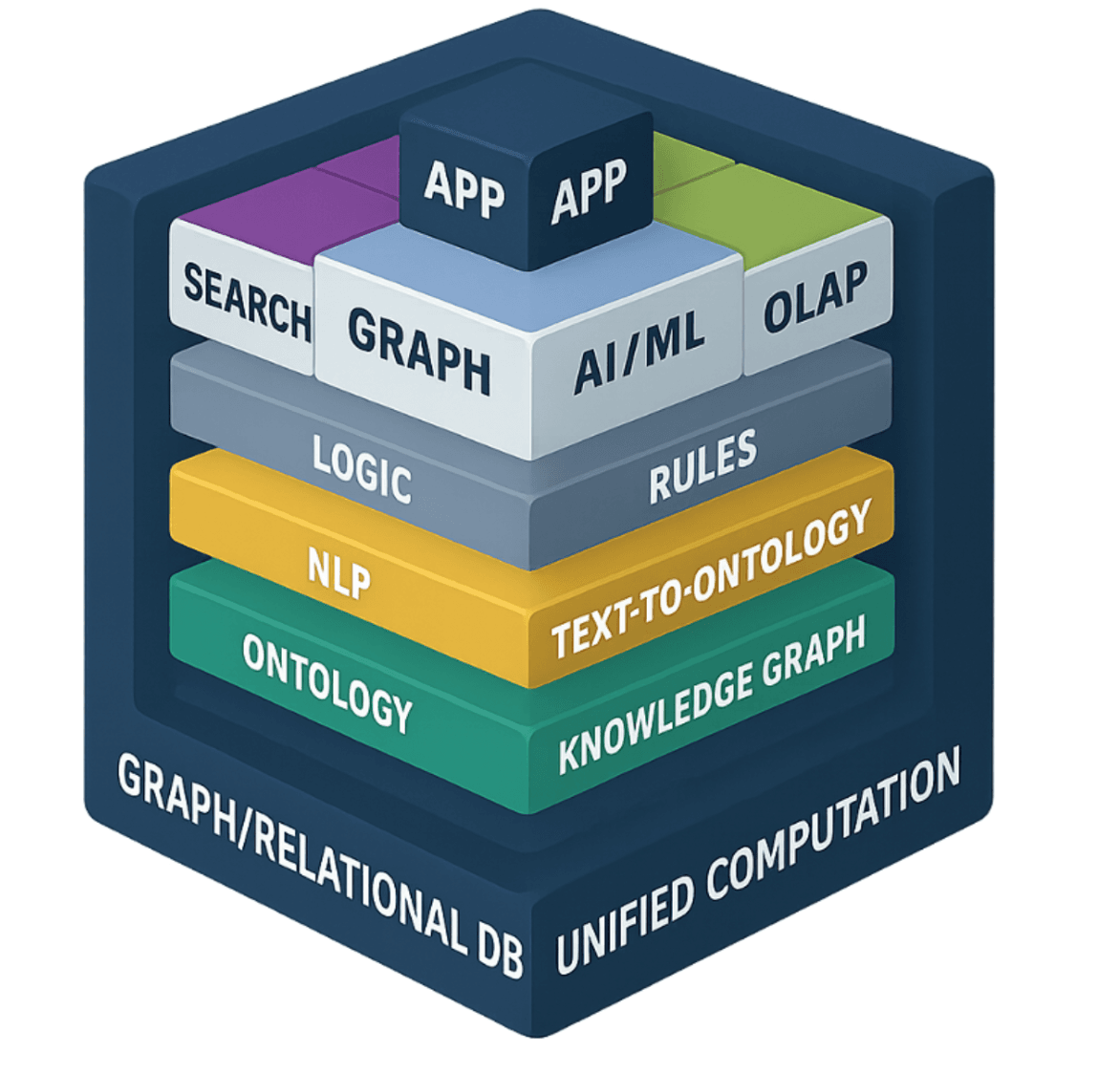
Figure 2: DataWalk Composite AI Core. An array of analytical techniques — from ontology and NLP to graph, AI/ML, and OLAP — run within one unified engine over a unified graph/relational database, enabling seamless, context-rich analysis.
DataWalk Composite AI Core means no compromises: it combines the speed and simplicity of graph analytics, the flexibility of semantic networks, and additional capabilities such as dynamic reasoning, risk-scoring, prototyping, schema-free modeling, and no-code analysis.
With these powerful capabilities, analysts can generate answers to their own questions and conduct dynamic, multi-dimensional investigations seamlessly.
Unmatched Agility For The Enterprise: Uniting Two Worlds
Even with the right data and tools, most organizations still struggle to act fast enough. This often results less from internal processes and more from the underlying architecture.
Traditional enterprise systems provide control and security but are complex, with multiple layers, engines, and data pipelines. Each change — adding a new source, adjusting a rule, or updating a model — requires synchronization across those layers, leading to weeks of delay.
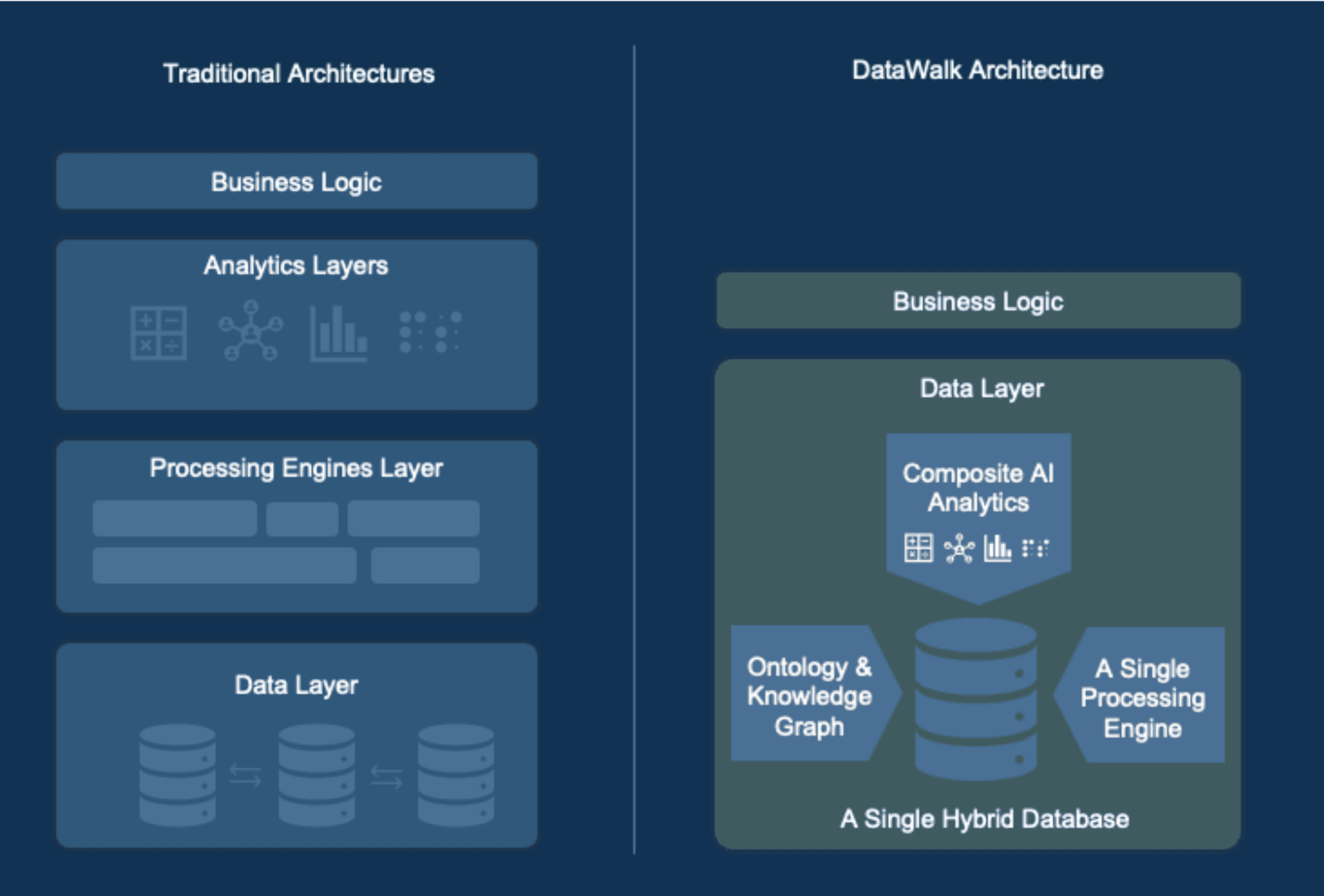
Figure 3: Comparison of Traditional Enterprise Architecture and DataWalk Architecture. Traditional enterprise systems rely on multiple disconnected layers—user tools, separate processing engines, and diverse databases and pipelines—often requiring data to be copied across BI and analytic platforms to achieve full analytical coverage. In contrast, DataWalk provides a unified architecture with a single layer that combines data, computation, and analytics directly within its knowledge graph database, eliminating redundant data copies and the need to move between disparate systems.
Lightweight desktop analytical tools, on the other hand, are agile but don’t scale, can’t handle large datasets, lack advanced analytics, and rarely meet regulatory or enterprise-governance standards.
To detect the undetected, extreme agility is essential. In security and financial investigations, time is critical — without agility, it’s impossible to test new hypotheses quickly, expand analytical scope, or respond to evolving threats. DataWalk’s patented technology eliminates these traditional issues.
Extreme Agility in DataWalk is achieved through three separate, but highly connected concepts:
- Data Management Agility: The ability to deliver a single source of truth with a 360° view of entities and relationships, eliminating data silos and keeping information continuously up to date for the analysis of emerging risks. It enables customers to independently integrate new data sources and turn them into actionable knowledge within minutes or hours — not weeks or months — while maintaining full data consistency.
- Analytical Agility: The power to enable fast insights and investigations by allowing analysts to work cases thoroughly, collaboratively, and without technical data preparation. DataWalk lets teams quickly uncover and adapt to new risks by enabling rapid hypothesis testing, extensive search, rule prototyping, and access to explainable no-code AI & machine learning algorithms for anomaly detection and more.
- Platform Agility: The strategic choice of a "Buy and Build" model using one self-maintained, extensible platform instead of multiple point solutions. DataWalk ensures fast deployment and configuration, can deliver ROI as fast as 6 months or less, and allows you to easily scale across different enterprise use cases.
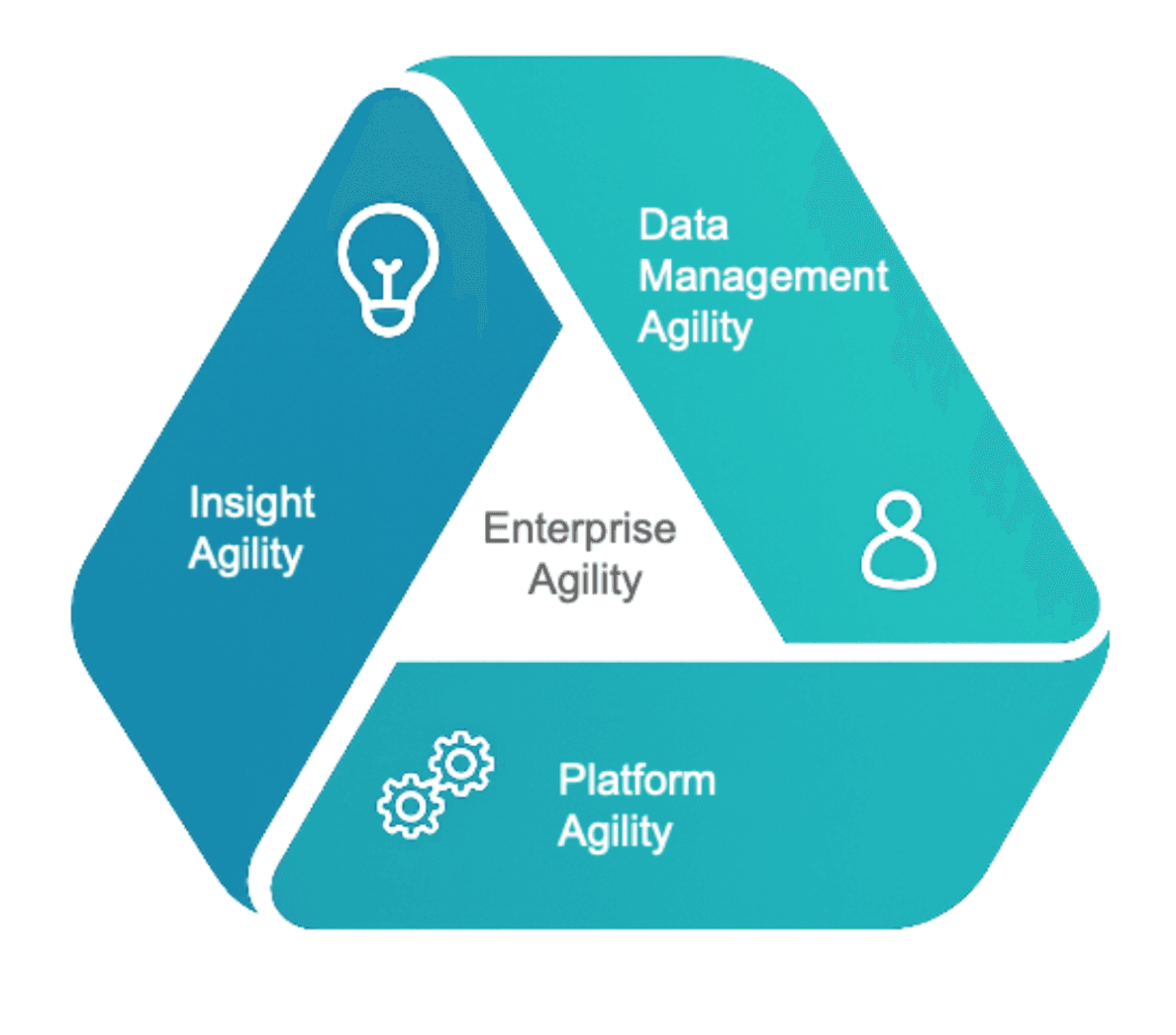
Figure 4: Enterprise Agility is the result of how customers leverage DataWalk for fast generation of new insights, platform configurations, and data operations.
DataWalk’s unique Enterprise Agility is enabled by our patented technology which unifies data and analytics in a single environment — one compute engine over one shared hybrid database. All analytic techniques (search, graph, OLAP, ML, and generative AI) operate together, with no internal data copying or cross-system synchronization.

Figure 5: The illustration above shows how a wide range of tasks — from answering new questions to scaling the system — can be executed quickly and seamlessly thanks to DataWalk’s unique architecture.
Unique DataWalk technology also allows instant adaptation to change — analysts can onboard new sources, adjust logic, and test hypotheses without rebuilding pipelines.
Unlike traditional platforms, integrating generative AI into DataWalk requires no architectural changes. Thanks to its unified design, scaling — such as onboarding new data sources or expanding analytical workloads — happens naturally and almost instantly.
This architecture enables organizations to combine enterprise scale with true agility, ensuring rapid responses to complex questions and emerging risks. In DataWalk, organizations never have to choose between performance and flexibility — they get both.
A New Work Paradigm: Analysts in Control
In traditional deployments, analysts depend on IT or vendors for every small change, such as adding a new source, a new rule, altering a complex query, or modifying a model. This slows progress and limits innovation.
DataWalk reverses that paradigm. From day one, your team — both technical and non-technical — works side by side with DataWalk engineers. Through workshops, certifications, and hands-on training, your team learns to manage and evolve your environment independently.
Users can:
- Load new data sources;
- Ask complex questions and test hypotheses without SQL
- Define rules and scoring mechanisms
- Build and deploy their own analytical applications — all without writing or maintaining SQL or code.
The result: analysts are not merely users of the system — they become co-creators. With full lineage, auditing, and access control, they operate independently within a secure enterprise framework.
Detecting the Undetected in Practice
- Financial Crime: Banks unify key data– transactions, KYC, devices, and social networks–into a single knowledge graph. Composite AI reduces false positives and exposes suspicious hidden networks.
- National Security: Intelligence agencies integrate HUMINT, SIGINT, and OSINT data, analyzing billions of records in real time within air-gapped environments. They can automatically convert hundreds of unstructured files into a knowledge graph for visual querying, pattern detection, and link-chart analysis.
- Law Enforcement: Police forces connect case files, license plate readers, and CCTV feeds to uncover patterns among vehicles, suspects, and events.
- Insurance: Insurers correlate claims, policy, and behavioral data to detect organized fraud rings, reducing losses and investigation time.
Across all these use cases, the formula remains the same:
Context + Composability + Agility = Discovery.
Conclusion: The New Paradigm of Detecting the Undetected
In an era where data grows faster than human capacity, detecting the undetected requires a new approach — one that unifies data, methods, and people in a single, composable environment.
- Foundation: a connected, ontology-based knowledge layer providing full context and a single source of truth.
- Tools: an integrated analytical engine combining search, graph, ML/AI/AI agents, NLP, and reasoning.
- Agility: the ability for analysts to work independently — without relying on engineers or waiting for IT.
DataWalk brings all these elements together in one architecture — combining the agility of desktop tools with the scalability and governance of enterprise systems.
With DataWalk, every organization can detect what others miss — and every analyst can connect, reason, and act freely.
That’s the new paradigm.
To detect the undetected, you must first rebuild the foundation.
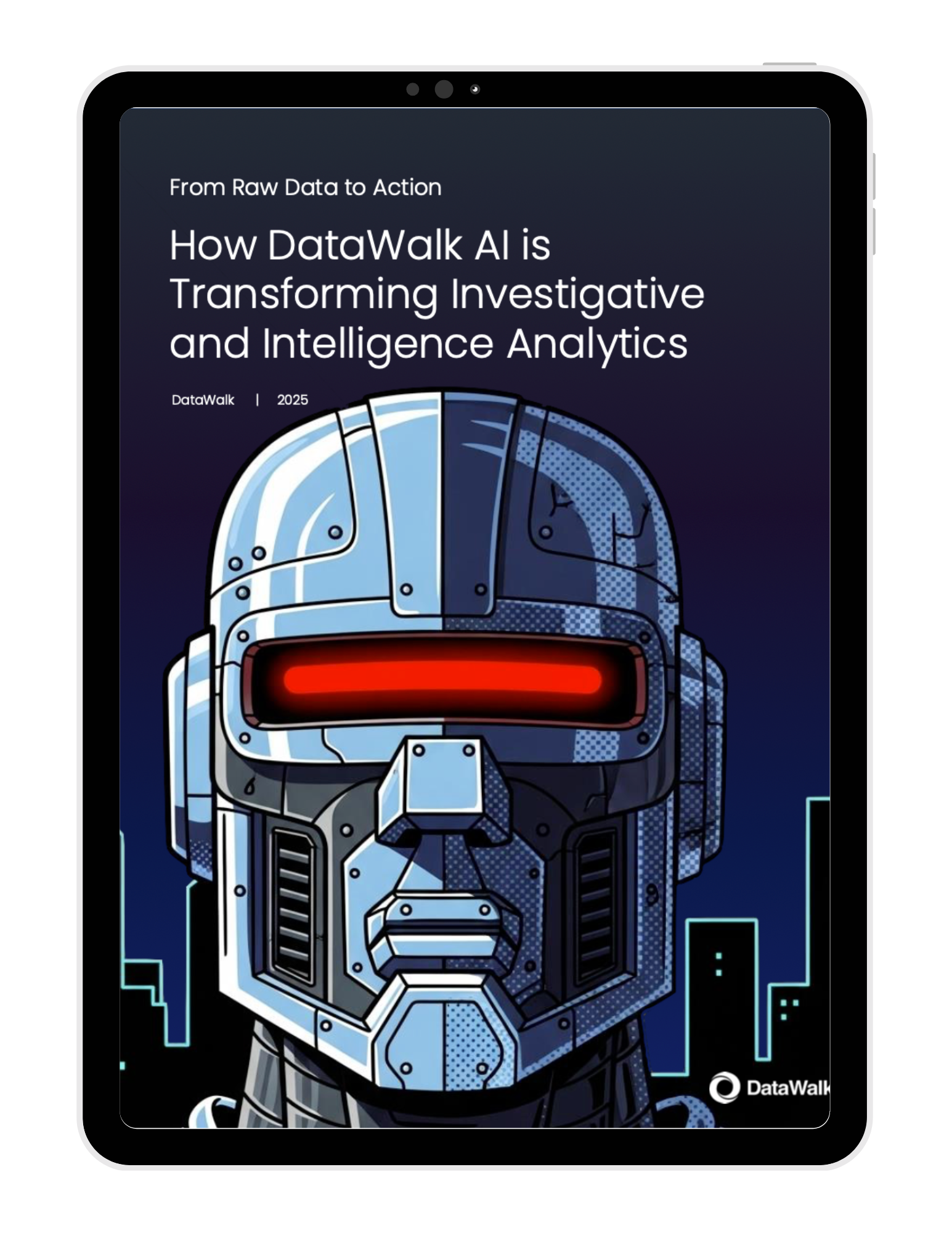
Table of contents
- A Mission to Uncover the Unknown
- Data Foundation: From Chaos to Context
- The Right Tools: Fusing Techniques in One Unified Environment
- Unmatched Agility For The Enterprise: Uniting Two Worlds
- A New Work Paradigm: Analysts in Control
- Detecting the Undetected in Practice
- Conclusion: The New Paradigm of Detecting the Undetected
FAQ
Join the next generation of data-driven investigations:
Discover how your team can turn complexity into clarity fast.

Solutions
Product
Partners
Company
Resources
Quick Links



